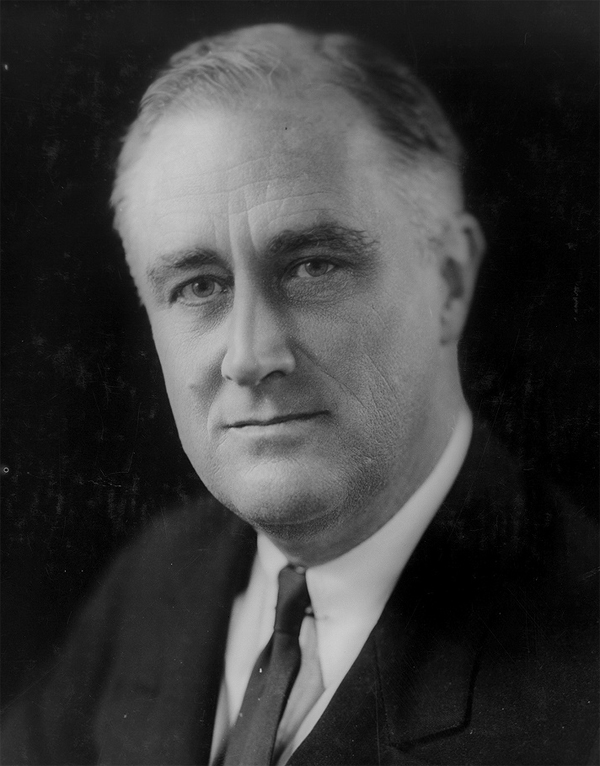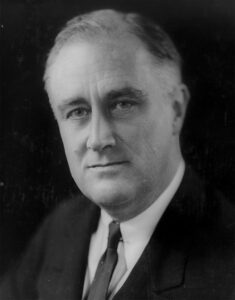New Deal in Louisiana
The effectiveness of President Franklin D. Roosevelt’s New Deal program in Louisiana was undercut by conflict with US Senator Huey P. Long.
This entry is 8th Grade level View Full Entry

Library of Congress Prints and Photographs Division
Franklin Delano Roosevelt
What was the New Deal and how did it change over time?
Franklin D. Roosevelt (FDR) was elected president of the United States in the fall of 1932. Before taking office in March 1933, he formed a “brain trust” of economists, social scientists, and progressive reformers to implement a plan to benefit people affected by the economic problems of the Great Depression. During his first 100 days in office, FDR released the first programs of his “New Deal.” Even though he emphasized relief for the poor, these first programs tended to benefit large businesses more than struggling citizens. The failure to solve the problems of everyday people gave rise to controversial figures like Father Charles Coughlin and Louisiana’s US Senator Huey P. Long. Both wanted more radical action for the people than was proposed in the New Deal. Responding to their criticism, FDR worked to expand his initial programs during the period of the “Second New Deal” in 1935–36. Still, FDR and his advisors always saw their efforts as emergency measures, not permanent programs. Despite this view the New Deal represented to many Louisianans, at the time and afterward, a commitment of the federal government to help struggling people.
How did the New Deal provide relief for the unemployed in Louisiana during the Great Depression?
One quarter of American adults were unemployed in the winter of 1932–33, and FDR was committed to providing relief through his New Deal programs. This relief came in the form of financial assistance and public works programs, which were given high priority. The primary program for relief distribution was the Federal Emergency Relief Administration (FERA). FERA worked through state-level offices to give out clothing, food, medicine, and cash to eligible struggling families. Other agencies directly employed workers on federally funded construction projects around the country. Notable among these were the Civil Works Administration (CWA), Public Works Administration (PWA), and Civilian Conservation Corps (CCC). Workers employed on such projects included architects, engineers, mechanics, and day laborers.
In Louisiana, as elsewhere, these relief efforts had an immediate impact. By January 1934 FERA was providing aid to around 400,000 Louisianans (almost 20 percent of the state’s population). By March of that year, Louisiana had spent $32 million on federally funded state projects. The CWA, a temporary sub-agency of FERA, paid out close to $15 million for wages and materials. The CCC developed reforestation, erosion-fighting, park-building, and road construction projects in the state and eventually employed more than 42,000 young men, including more than 8,000 Black Americans. Kisatchie National Forest and the early state parks system, for example, were almost entirely CCC creations.
How did Huey P. Long affect the efforts of the New Deal in Louisiana?
Conflict between FDR and Louisiana’s strongman, US Senator Huey P. Long, undercut the effectiveness of relief in the state. Long wanted to eventually become president and saw FDR as a potential rival. He therefore wanted to prevent FDR’s administration from interfering in Louisiana politics and worked to limit the New Deal’s influence in Louisiana. As a result FDR gave funds to Long’s political opponents, the “anti-Longs.” While other states received a major increase in federal money during the mid-1930s, leading to a surge in public employment and building, aid to Louisiana stalled. (In fact, fewer than three dozen Public Works Administration (PWA) construction projects were fully authorized before Long’s assassination in September 1935.) In August 1934 the Federal Emergency Relief Administration (FERA) temporarily stopped providing relief to the state. This action threatened Long’s popularity and he eventually complied with a mandate to establish a public welfare department. Although beloved by the state’s working classes, Long’s death actually brought them and Louisiana a greater share of the New Deal’s benefits. Leaders who came after Long realized that supporting New Deal programs would help their popularity. Governor Richard Leche and New Orleans Mayor Bob Maestri dropped Long’s controversial Share Our Wealth program and fully supported FDR and the New Deal. In return FDR promised significant federal dollars for public works in Louisiana. In this “Second Louisiana Purchase,” FDR bought the political support of the state’s leaders. Louisiana thus experienced the most New Deal benefits between 1937 and 1940, rather than earlier in the decade as in other states.
What kinds of public works did the New Deal fund in Louisiana?
Among the most active agencies at work during this era in Louisiana history was the Public Works Administration (PWA). By mid-1939 the PWA had spent more than $79 million on various projects. Barksdale military base, near Shreveport was expanded by the PWA. Charity Hospital and the Huey P. Long Bridge, both in New Orleans, were built through the PWA program. The program also was responsible for the construction of classrooms, offices, shops, and other facilities at Louisiana’s major colleges and universities. The PWA built more than four hundred structures in the state and renovated many more, including civic buildings, community centers, courthouses, and airports.
The Works Progress Administration (WPA) was established during the second New Deal of 1935. The WPA spent more than $80 million on roads, bridges, water and sewerage systems, parks, playgrounds, public housing, and other projects in Louisiana. The WPA also oversaw a variety of relief and work activities like hot-lunch, library, and bookmobile programs; educational and vocational classes; and literacy drives. The WPA is perhaps best remembered for the Federal One program. This program established the Louisiana Writers Project, the Louisiana branch of the Federal Art Project, and similar programs in music and theater. These agencies were some of the most creative and politically left-leaning of the New Deal. They employed writers, historians, musicians, artists, and actors to create art that expressed appreciation of American regional cultures.
How did the New Deal reform agriculture in Louisiana?
Public Works Administration (PWA) and Works Progress Administration (WPA) projects are the most well-known New Deal programs today. However, reforms in agriculture had a larger impact on Louisiana. The Agricultural Adjustment Administration (AAA) changed rural life in Louisiana permanently, especially in the rice and sugar industries. It created a system that favored large-scale, commercial agricultural operations over traditional small farms. The AAA program gave large-scale agricultural operations government support and market stability.
Under the AAA, cotton farmers were incentivized to reduce production by limiting their total acreage. This decrease created an artificial shortage that then led to higher market prices. Prices for cotton went from under five cents a pound in 1931–32 to thirteen cents in 1934. In addition the federal government paid farmers rent for their unused land. By the end of May 1936, cotton growers in Louisiana had received more than $30 million in rent payments. Further, farmers were also able to profit by planting the unused acreage with other crops or using it for animal pastures. Throughout the 1930s large-scale farmers diversified their crops, mechanized their operations, and reduced their dependence on hand labor. This led to an increase in agricultural income in the state. In 1929 agricultural income was $170 million. In 1932 agricultural income had decreased to $59 million. By 1937 agricultural income had risen to $130 million. This success led to the creation of the modern farm system supported by federal funds.
Unfortunately, the AAA program disrupted the lives of many of Louisiana’s sharecroppers and farm laborers. Landowners receiving federal rent payments were required to share them with their tenants. A half-share tenant would be given half the check amount and so on. However, most landowners kept the entire check. Many tenants were either moved off the land entirely or reduced to day laborers.
Eventually, the US government attempted to fix the plight of these poor farmers through the programs of the Resettlement Administration and later the Farm Security Administration (FSA). The FSA gave small farmers low-interest loans for land, equipment, and stock purchases. It also set up several community farm projects like Crew Lake in northeastern Louisiana and Terrebonne in the southern part of the state. However, these efforts did little to change the lives of most rural folks in Louisiana.
The New Deal helped stabilize the US economy and gave people a sense of purpose. These are its greatest achievements. Some New Deal programs were tremendous successes, but there were also many failures and unintended outcomes. Most importantly, FDR created the framework for a powerful federal government that expanded its size during the coming world war and in the decades after. But FDR was unable to solve many of the deep inequities found in 1930s American society. Those problems were left for later generations.
